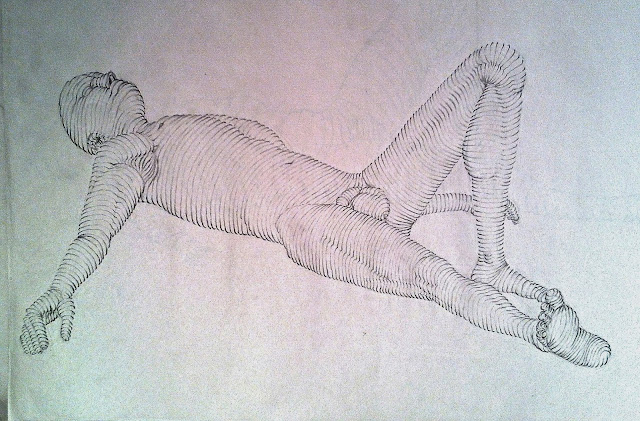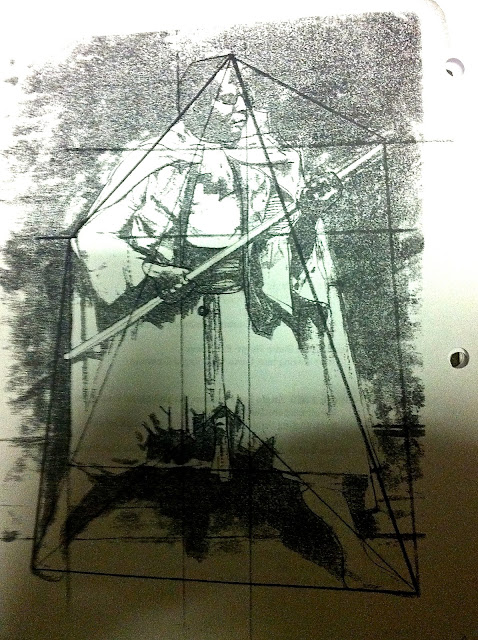Jessica's relief drawing has a very good sense of spacial awareness (the foreground hand and foot have been enlarged - this allows these forms to come forward).
 |
| Frank's After Drawing Relief Cross-Contour Reclining Figure hair has been fixed so that it now follows contours of the form |
 |
| Franks Before Relief Cross-Contour Reclining Figure Drawing |
In this image, each shade of gray represents a height in the final rendered map, being white the highest height and black the lowest height. In fact, any grayscale image can be used as a Digital Elevation Map. It is just that real height maps look better than faked height maps, unless you are trying to achieve a “unreal” look.
William Berry's book, Drawing the Human Form has a large section dedicated to Relief Tonal Rendering. We can now begin to add tone to our quick drawings using this idea. (see Handouts)
AND now
... some very fine work done by some Art Fundamentals' students
... some very fine work done by some Art Fundamentals' students
(some drawings just needed a few tweaks we discovered during critique)
a before & after drawings
More Student Relief Cross-Contour Drawings
 |
| internal lines along torso could be more gradually integrated so they blend good use of overlap showing foreshortening and size differences between feet & hands to show proximity to viewer |
do a quick light drawing - concentrate on outer 3 points & lock into
points so you can complete a rapid contour once angles are discerned
see the triangle in your minds eye and get it drawn on the page
if it's too small you can enlarge it & lock into points on drawing
that are farthest North, Southwest and Southeast on the page
begin measuring and finding proportions (see below)
BASIC SHAPE EXERCISE
(Measurements + Proportions)
To do a realistic rendering, we want to employ careful observation and engage our intuition. In other words, we want our drawing to be accurate but not at the expense of losing the gesture. To do this, we will swing back and forth between some right and left brain techniques in this exercise.
NOTE: BEGIN with a VERY LIGHT and LOOSE DRAWING (first use your L-frames to see if the pose is horizontal or vertical and turn your paper so that the Frame of Reference echoes his). This gets something on the page to correct. Use the following (and an eraser) to make corrections to your very light drawing. Keeping your work light while you are checking landmarks on your drawing will alleviate frustration.
1. THEN find LARGEST ‘Basic (square/circle/triangle) Shape’ that holds pose [(or almost the entire pose) NOTE: Small portions can be outside the envelope. In all the poses we will be doing from now until the end of the 1st Semester, you will be looking for a triangle. Ask yourself where the farthest point North on your page is and lock it into place by drawing a line from this point to the lowest point Southwest on your page and lock it in while you join it to the lowest point Southeast on your page (include the chair and cube if applicable).
· If necessary, find other ‘Basic Shapes’ required to enclose the rest of the pose in its’ entire envelope. See example; [large triangle + two smaller triangles (on either side) = Pentagon Envelope ... proceed to find as many triangles within the pose as you can and check to see that your angles match what you see in the pose ] (left brain)
· If the shape(s) need(s) to be reduced or enlarged in size, now is the time to do this. Make sure to take great care at this stage in creating the right shape. AND don’t change shape(s) when changing their size (or centering it/them).
NOTE: When centering your shape(s), remember to place ‘intuitive’
center onto the central diagonal ‘cross-hairs’ of your drawing paper.
2. Continue your very light and loose drawing inside the envelope [go over gesture (action lines (S/C-shape(s), axis points, etc.) and redevelop your very light quick contour (same thing as a rapid contour). Don’t draw too loosely though. You need to be sure your drawing fits properly within the envelope and that the points on the figure you initially used to create the LARGEST ‘Basic Shape’ are locked into place properly. (right brain)
3. Progressively find ‘Next Largest’ Basic Shapes within LARGEST ‘Basic Shape’.
As an artist, you learn to see the subject as one holistic shape rather than as we might naturally be accustomed (seeing parts first that make the whole).Again, work your way through this part of the exercise, finding the next largest shape … then next largest (left brain) … make light adjustments to drawing (right brain)
4. Find your first ‘unit of measurement’. NOTE: Remember to line yourself up perpendicular to the model (and straighten your drawing board and drawing pad). Many artists use the head as a unit of measurement. Try this (don’t be fooled into believing there are always a set number of ‘heads’ in the figure. Artists in the past attempted to ascertain perfect proportions and often adhered to strict guidelines; but in trying to free themselves with formulas they actually restricted themselves to nearly impossible situations and standards. As soon as a person leans forward, their head is foreshortened. As soon as a person stops standing in an upright position, the measurements no longer hold. If you are drawing a person who doesn’t have ‘classically perfect proportions’, your formulas won’t work. It is always best to learn to make measurements for each drawing you do (whether it be of people, places or things).
Begin by holding your measuring tool (pencil = plumb line) loosely in your hand at the top and let it drop down and settle until you can sight a true vertical position (using your ‘camera eye’). When you know where true vertical is, you can hold your pencil firmly at the bottom, keeping your arm straight (remember to lock your opposite arm into your body so you can cup the elbow of the arm holding the measuring tool into the palm of your opposite hand). Be careful to choose points on the head that you can always return to when rechecking your measurements (ie, where the hair meets the forehead, the crown of the head, etc). How many heads fit into the pose you are drawing? How many heads are there in your very light and loose drawing? How many heads fit into half the length of the pose? (what about a quarter of it)? You can check to see if your drawing stands up to these tests now! (left brain)
5. Make adjustments to your light and loose drawing (use your eraser and continue to draw very lightly and loosely (but not too loosely). (right brain)
6. ‘When we measure, we find a proportion.’ In other words, when we are measuring we are finding the relationship between height and width.
HOW TO measure the height and corresponding width of the pose (ie, ‘Basic Shape.’)
· Hold measuring tool upright in the vertical position. Line up the top of your tool with the top of your subject and adjust your fingers so they mark the bottom of the subject. This unit of measurement corresponds to the height of your subject from your (stationary) point of view (POV).
· Without shifting your fingers, turn your tool horizontal (line horizontally up with the edge of your drawing board). With your free hand mark off the width of your subject (at its’ widest points). [The relationship between the two measurements is the ratio of proportions to one another.] We can get very left brain at this point and take out a ruler to see what the numerical values are so we can check on our drawing pad to see if we need to make adjustments.
[and again - back to the enjoyment of doing light and loose ‘fix up’ drawing] right brain
7. Check strong diagonals in the pose. Using your body as a ‘tool’, stand up straight; and one by one, line up the diagonals using your measuring tool. For each, drop your arm straight down onto the paper without twisting your body. They should correlate directly with angles you have ‘sighted’. Sometimes, it’s useful to pretend your measuring tool is able to be inserted into the figure (as if it is part of an armature on a sculpture and/or an actual bone in its’ skeleton) to see if angles on a leg or an arm have been properly seen and drawn. (left brain)
[and again - back to the enjoyment of doing light and loose ‘fix up’ drawing] right brain
8. Drop vertical (and horizontal) lines down (and across) your subject to check and see if things are lined up properly beneath specific points.
[and again - back to the enjoyment of doing light and loose ‘fix up’ drawing] right brain
 |
| internal lines along torso again could be more gradually integrated so they blend a good understanding of the form of the hair is seen here |
 |
| another set of lines between each of these lines would depict form more readily good use of contour line around head and nice use of contour lines describing twist of torso towards viewer |
 |
| this drawing has used outline to describe edges - it needs to be erased between contour lines using hooking to do this excellent placement and sizing on the page illustrating good use of the envelope to locate figure within |
 |
| again drawing has used outline to describe edges and needs to be erased between contour lines & use hooking and again excellent placement and sizing on the page illustrating good use of the envelope to locate figure within |











No comments:
Post a Comment